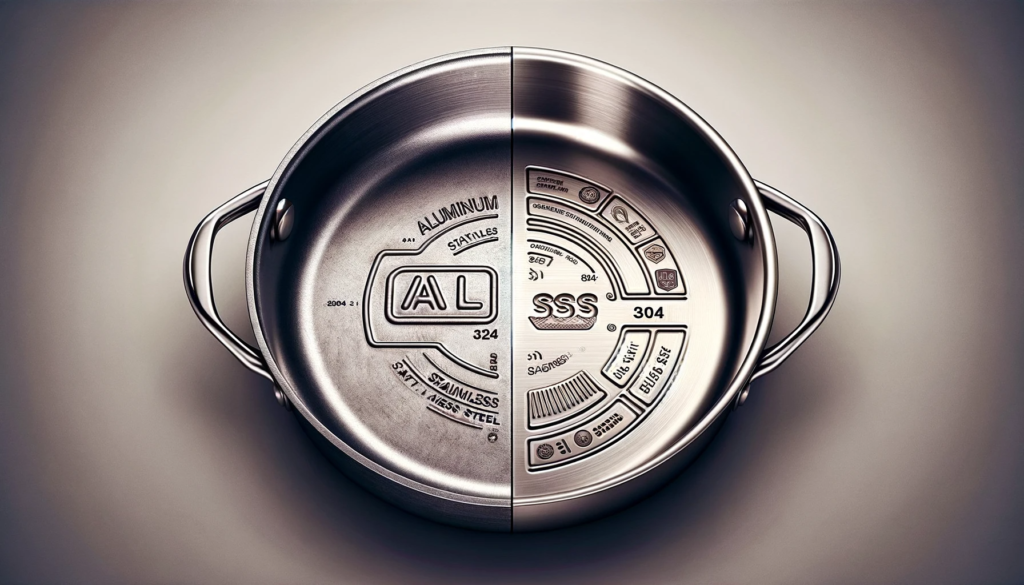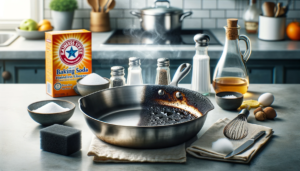Ever scrutinized a pot wondering, aluminum or stainless steel? Accurately identifying cookware materials matters more than you’d guess.
Aluminum and stainless steel have distinct visual, physical, and chemical traits allowing certain identification with simple home tests.
Let’s examine how to conclusively and confidently tell aluminum from stainless steel cookware using clues you likely have on hand already.
How to Tell Aluminum from Stainless Steel Cookware

The quickest way to determine if cookware is aluminum or stainless steel is to use a magnet.
Since stainless steel contains iron it will attract magnets, while non-ferrous aluminum remains completely unaffected.
You can also identify aluminum cookware by its dull gray hue that lacks shine, feather-light weight when lifted, potential reaction from vinegar resulting in discoloration, and any “AL” branding marks etched on the surface.
Stainless steel will have a mirror finish, feel heavy when hefted, withstand vinegar exposure without damage, and have “SS” or certification logos stamped instead.
1. Look at the Color and Shine

The color and shine, or lack thereof, can be telling signs to identify aluminum and stainless steel cookware.
Aluminum has a dull, lackluster appearance while stainless steel maintains a strong shine over time.
Aluminum cookware typically has a grayish silver colored surface.
Even when the aluminum is freshly polished and buffed, it has a hazy quality and fails to have a mirror-like sheen.
Unfortunately, frequent scrubbings and cleaning will cause aluminum to become even duller and lose its luster.
This happens because using and washing aluminum cookware leads to oxidization on the surface.
Oxygen molecules bond with the aluminum atoms to create a thin aluminum oxide layer with a darker, grayish hue.
No amount of polishing can brighten this oxidization effect.
So as aluminum cookware ages and becomes well-used, it takes on a perpetually gray, clouded aesthetic that lacks reflectivity or brilliance.
On the opposite end, stainless steel cookware is prized for its iconic shiny appearance.
The alloy of metals including chromium, nickel, carbon, and others in stainless steel helps it strongly resist oxidization that dulls aluminum over time.
As a result, stainless steel maintains its beautiful, mirror-like finish decade after decade, even with heavy cooking usage.
Whether recently bought or heirloom antique pots passed down generations, stainless steel cookware will have at least some level of glimmer and shine to it.
The light dances along the reflective stainless steel surface in a way that aluminum cannot match after months of cooking acidic tomato sauce or scrubbing burnt food debris.
So when distinguishing cookware materials, keep in mind aluminum has a hazy gray dullness while stainless steel appears bright and brilliant.
2. Check for Magnetism

An easy and definitive way to determine whether cookware is aluminum or stainless steel relies on magnetism.
Stainless steel contains iron which makes it highly magnetic.
On the other hand, aluminum is a non-ferrous metal completely lacking iron content, meaning aluminum is not magnetic whatsoever.
Take a typical refrigerator style magnet or any moderately strong magnet and systematically test various sections of the cookware.
Move the magnet over the interior cooking surface, exterior walls, along the bottom, and even try sticking it to any lid or handles belonging to the cookware set.
If the magnet adheres strongly when brought near the cookware, this confirms stainless steel material.
The magnetic pull feels firm and it takes effort prying off the magnet.
However gentle the magnet contact, stainless steel generates an attraction thanks to its iron makeup.
In contrast, when waved over aluminum cookware, the magnet will immediately fall away with zero magnetic pull.
No matter where on the aluminum pan you place the magnet, it will simply not adhere.
Aluminum’s non-magnetic property makes the magnet slide freely over the surface before disengaging entirely.
This magnet evaluation takes only seconds and gives a definitive binary yes or no whether cookware is magnetic stainless steel or non-magnetic aluminum.
Relying on magnetism clues removes anyguesswork trying to decipher aluminum from stainless steel pieces.
3. Examine the Weight

Hefting cookware in your hands also gives reliable clues whether the material is lightweight aluminum or dense stainless steel.
Aluminum’s claim to fame lies in its featherlight weight.
With a density around one third that of stainless steel, even sizable aluminum stockpots seem airy and insubstantial when lifted.
The soft, flexible aluminum metal feels thinly rendered and lacks the heft you’d expect from such a voluminous cookware piece.
Professional aluminum cookware sets pride themselves on keeping poundage low to avoid arm strain for cooks hoisting and maneuvering the pots all day long in a commercial kitchen.
Compare this to stainless steel’s substantially heavier weight and solid feel.
The high iron content paired with nickel and chrome makes stainless steel nearly three times more dense than aluminum.
So similar sized stainless steel cookware will have a markedly heavier sensation in hand.
Lifting a stainless steel stockpot off the shelf, it has a sturdy, weighty quality from the get-go.
The thick sides and base give stainless steel cookware noticeable substance and resistance, similar to lifting a dumbbell rather than an empty milk jug.
Pay attention to this weight differential as you handle various unspecified cookware pieces around your kitchen.
Gently heft pots and observe how substantial they feel, gauging expectations around true poundage.
Surprisingly light pieces likely point towards aluminum construction based on lower metal density.
Any cookware with noticeable resistance and mass while lifting signals durable stainless steel.
4. Test with Vinegar

Using vinegar provides an easy at-home test indicating aluminum or stainless steel material.
White vinegar has an acetic acid that reacts to aluminum metal but leaves stainless steel unscathed.
Apply a quarter-sized amount of white vinegar directly onto the cookware surface.
Choose an inconspicuous area on the base or along the sides to test first.
Examine if any bubbling action or fizzing occurs when the vinegar initially makes contact, suggesting an active chemical reaction.
After dripping vinegar over the test area, allow 10-15 minutes of dwell time before rinsing away.
This gives adequate time for the acidic vinegar to fully react with the metal cookware surface.
Upon close inspection, aluminum surfaces may display discoloration, dark spots, pits, and etching wherever the vinegar droplets touched down.
These effects come from acetic acid eroding and bonding to the aluminum metal itself.
In extreme cases, vinegar eats holes straight through thin or compromised aluminum.
By comparison, stainless steel’s chromium oxide layer protects it from corrosion and reactivity.
Vinegar may leave behind dried residue once rinsed off stainless steel but fails to alter or mark the actual surface.
Stainless steel withstands exposure to vinegar’s acidic effects due to its chemical resistance from added alloys.
Repeat vinegar testing over multiple areas of each cookware piece with unknown metal composition.
Any bubbling reaction or resulting pitting likely confirms aluminum material.
Meanwhile stainless steel remains visibly unchanged besides surface dirt easily scrubbed away.
Using this clue, aluminum and stainless steel cookware can be successfully identified at home.
5. Look for Branding Marks

Etched codes, logos and certifications on cookware often explicitly identify the metal type as either aluminum or stainless steel.
Seek out and interpret these definitive manufacturer’s marks when still uncertain between the two after other tests.
Closely scan all outer and underside surfaces of perplexing cookware in search of any engraved branding language cooked into the metal itself.
Aluminum pieces frequently have “AL” or the full name “aluminum” stamped somewhere.
Stainless steel tends to feature markings like “SS” for shorthand or “stainless steel” spelled out.
Additionally model numbers or product codes related to metal type may appear, requiring some decoding through Google.
If corrosion resistant grades of stainless steel are used like grade 304 or professional grade 430, this info is typically etched by manufacturers as well.
When found, official certification logos prove invaluable determining for stainless steel versus aluminum.
For example, the nickle and chrome content percentages that define stainless steel may be etched as 18/8, 18/10 or 18/0 markings.
These legally regulated logos assigned by the Steel Founders Society of America confirm stainless steel products meeting specific compositional standards.
Research any numerical branding similar.
Likewise, logos may be accompanied by “anodized aluminum” or other descriptors confirming construction material.
Match photos of your cookware markings against internet image searches to accurately interpret logo meanings.
Using Google for fact-checking when deciphering letter combinations or unknown logos prevents false assumptions.
Conclusion
Identifying cookware materials relies on telling visual and physical clues between aluminum and stainless steel.
Aluminum has a dull gray oxidization, fails the magnet test completely, impresses with its ultra-light weight and may bubble when exposed to vinegar.
Stainless steel maintains shine, sticks to magnets, feels hefty when lifted and withstands corrosion from vinegar’s acidity.
Lastly, etched codes and logos on cookware often explicitly name the metal type.
Combining these identifying tests allows even unfamiliar pots and pans to be easily categorized as either aluminum or stainless steel.
Correct cookware identification then empowers proper usage based on the quirks of each respective metal.
Now any cook can become a sleuth seeking out clues to conclusively tell aluminum and stainless steel cookware apart.



